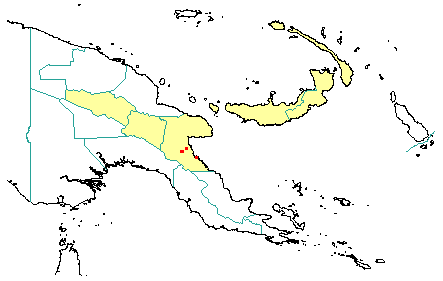
in PNGplants database
PNGTreesKey – Pouteria luzoniensis (Merr.) Baehni var. papuana Erlee |
Barry Conn (NSW) & Kipiro Damas (LAE).
Guide to trees of Papua New Guinea
Copyright held by the authors, National Herbarium of New South Wales, and Papua New Guinea National Herbarium
Blumea Vol. 8: 502 (1957)
Family: Sapotaceae
Dicotyledon
Timber Group: Occasional timber species
Field Characters: Large canopy tree (up to c. 26 m high); Bole markedly fluted (25-30 cm diam.); straight (bole up to c. 20 m long); buttresses buttresses present (buttresses up to c. 1 m high); spines spines absent; aerial roots aerial roots absent; stilt roots stilt roots absent; Bark grey or brown, rough, scaly or flaky or slightly tessellated; Subrhytidome (under-bark) brown (with pale reddish tinge); less than 25 mm thick, 3.0; bark blaze consisting of one layer; faintly to non-aromatic; outer blaze pink or brown, markings absent, smooth or slightly fibrous; inner blaze pink or brown, markings absent, smooth or slightly fibrous; bark exudate (sap) present, white/milky, not readily flowing (spotty), colour not changing on exposure to air, sticky; terminal buds not enclosed by leaves.
Indumentum: Complex hairs absent; stinging hairs absent; mature twig indumentum (hairs) absent.
Leaves: Leaves spaced along branches, spiral (leaves occurring singly at a node and arranged spirally up the branchlet), simple (a leaf composed of a single blade); petiole present, not winged, attached to base of leaf blade, not swollen; leaves rarely broadest above middle, broadest at or near middle, or broadest below middle, 3.0-18.0 cm, 1.8-6.5 cm; symmetric, entire, not dissected or lobed, rounded, obtuse, sub acute, or acuminate, venation pinnate, secondary veins open, not prominent, but visible, intramarginal veins absent; leaves lower surface red (dull caused by presence of reddish hairs), upper surface dark green, indumentum (hairs) present, indumentum (hairs) dense (with reddish hairs); absent; domatia absent; stipules absent.
Flowers: Inflorescence axillary, flowers arising from a single point (2-6-flowered), cones absent; flowers bisexual, not stalked or stalked (shortly), flowers with many planes of symmetry, 4.0-5.0 mm long, diameter small (up to10 mm diam.) (4-5 mm diam.); perianth present, with distinct sepals and petals whorls, inner perianth white or cream-coloured; 5, some or partly joined; stamens 5, present, free of each other, joined to the perianth; ovary superior, carpels joined (when more than one), locules 4-5; styles solitary, 1.
Fruits: Infrutescence arising from single point, fruit 20.0-23.0 mm long, 24.0 (c.) mm diam., brown or purple, not spiny, fleshy, simple, indehiscent, berry; seeds 1-2, much more than 10 mm long (12-16 mm long), not winged, broad (as wide as long), seed more than 10 mm diam. (10-14 mm diam.).
Distribution: Morobe, Western Highlands, Eastern Highlands, New Britain & New Ireland.
 | Botanical records in PNGplants database |
Notes: Notes It is not clear if this variety should be transferred to the genus Planchonella or remain in Pouteria. It is here maintained within the genus Pouteria until the relationship between these two genera is resolved. However, it is expected that this taxon will probably be transferred to the genus Planchonella.